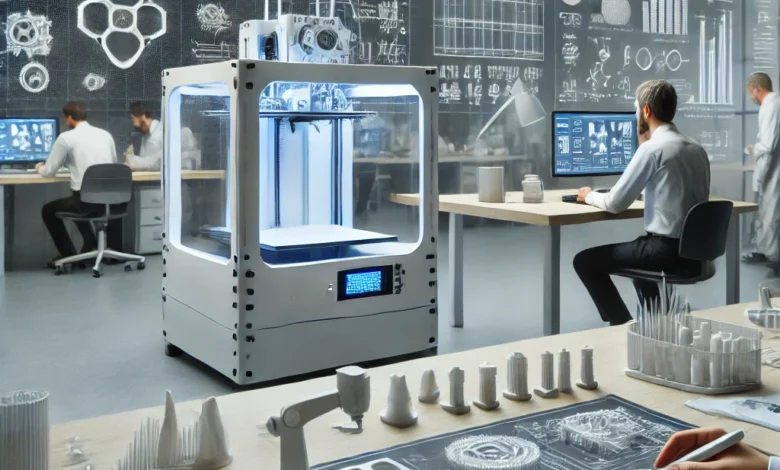Speed up Your Product Development with Expert Rapid Prototyping Services

In today’s fast-paced and ever-evolving market, businesses must stay ahead of the curve by introducing innovative products that meet customer demands and industry standards. One of the key strategies to accelerate this process is leveraging rapid prototyping services. Rapid prototyping is a game-changer for product development, offering a streamlined and cost-effective way to transform ideas into tangible prototypes quickly and efficiently. Whether you’re a startup or an established company, rapid prototyping plays a crucial role in speeding up the product development timeline and ensuring that your designs are both functional and manufacturable.
Rapid prototyping allows businesses to iterate on their designs quickly, test out ideas, and make necessary adjustments without the lengthy delays associated with traditional manufacturing methods. This not only reduces costs but also minimizes the risk of producing defective or unfeasible products. In this blog, we’ll explore how expert rapid prototyping services can revolutionize your product development process and why they are essential for businesses looking to innovate.
What is Rapid Prototyping and Why is it Important?
Rapid prototyping is the process of quickly creating a physical model or prototype of a product using digital designs. Typically, this involves using advanced technologies such as 3D printing, CNC machining, or injection molding to produce a prototype that closely mimics the final product. The primary goal of rapid prototyping is to shorten the development cycle, allowing designers, engineers, and stakeholders to visualize and evaluate a product’s design before committing to large-scale production.
There are several reasons why rapid prototyping has become indispensable in modern product development:
1. Faster Time-to-Market
Time is critical in the competitive world of product development. Companies need to get their products into the hands of consumers as quickly as possible, especially when dealing with rapidly changing trends or emerging technologies. Rapid prototyping significantly shortens the product development timeline by enabling quick iterations and modifications, ensuring that the final product is market-ready sooner.
With the ability to produce a prototype in a matter of days, companies can test and refine their designs faster than ever before. This accelerates the overall development process, allowing businesses to move from concept to production with greater efficiency.
2. Cost-Effective Design Iterations
Making changes to a product design during the traditional manufacturing process can be both time-consuming and costly. However, rapid prototyping allows companies to test different design iterations quickly and affordably. Using digital files, prototypes can be produced, evaluated, and modified multiple times without the need for costly molds or tooling. This enables designers and engineers to perfect their product without overcommitting to any one design direction.
The ability to produce inexpensive prototypes also means businesses can catch design flaws early, avoiding expensive mistakes later in the process. This ultimately saves money and resources, making the entire development cycle more cost-efficient.
3. Enhanced Collaboration and Feedback
In the past, product development was often an isolated process, with designs being kept secret until the final product was unveiled. With rapid prototyping, however, collaboration among teams becomes much easier. Designers, engineers, marketers, and even end-users can interact with the prototype early on, providing valuable feedback on its functionality, aesthetics, and usability.
This feedback loop is essential for creating products that truly meet the needs of customers and the market. With the ability to quickly share tangible prototypes, teams can ensure that they are all aligned in their vision and working toward a common goal.
The Benefits of Rapid Prototyping Services for Your Product Development
Choosing to use rapid prototyping services offers a wide range of benefits that can significantly impact the quality and speed of your product development process. These services are typically offered by expert prototyping companies that have the experience and technology to bring your ideas to life with speed, precision, and accuracy.
1. Increased Design Accuracy and Quality
One of the most significant advantages of rapid prototyping is the ability to produce prototypes that are highly accurate and close to the final product. Using advanced technologies such as 3D printing or CNC machining, prototyping companies can create detailed models with intricate features and complex geometries. This high level of precision allows designers and engineers to test the functionality of each part of the design and ensure that everything works as intended.
With rapid prototyping, you can spot potential design issues or flaws early, enabling you to correct them before moving on to mass production. This level of scrutiny and testing helps ensure that the final product is of the highest quality, meeting both functional and aesthetic standards.
2. Customizability for Unique Projects
Every product development project is unique, and sometimes, off-the-shelf solutions simply won’t cut it. With expert rapid prototyping services, you gain the ability to customize prototypes to meet your specific needs. Whether you’re developing a new consumer electronics product, medical device, or industrial component, prototyping services allow for tailored solutions that match your exact specifications.
Custom prototypes can be designed and produced in a range of materials, such as plastics, metals, or composites, depending on the intended use. Whether you’re testing for fit, function, or performance, rapid prototyping services can create the exact prototype you need to validate your design.
3. Reduced Risk in Product Development
Every product development process involves some level of risk, particularly when it comes to bringing new products to market. However, rapid prototyping helps mitigate that risk by allowing you to test, refine, and perfect your designs before committing to mass production. By creating prototypes early on, you can identify potential flaws in the design, usability, or manufacturability of the product, reducing the risk of costly production errors later.
Additionally, rapid prototyping allows for testing in real-world conditions, providing valuable data on how the product will perform in the hands of consumers. This helps to ensure that the final product is not only functional but also market-ready.
Different Types of Rapid Prototyping Technologies
The success of rapid prototyping relies heavily on the technology used to create prototypes. Depending on the complexity and requirements of the project, various rapid prototyping techniques can be employed. Each of these technologies has its own strengths and advantages, depending on the specific needs of the product.
1. 3D Printing (Additive Manufacturing)
3D printing, or additive manufacturing, is one of the most popular methods for rapid prototyping. This technique involves building up layers of material based on a digital design to create a three-dimensional object. 3D printing offers tremendous flexibility in terms of design complexity, enabling the production of intricate geometries and internal structures that would be impossible to achieve with traditional manufacturing techniques.
3D printing is also incredibly fast, allowing for quick iterations and testing of different designs. It’s suitable for prototyping products in a variety of industries, including consumer electronics, automotive, medical, and aerospace.
2. CNC Machining
CNC machining is another widely used method for rapid prototyping. Unlike 3D printing, CNC machining is a subtractive process that involves removing material from a solid block to create the desired shape. This method is ideal for producing prototypes that need to be made from metals or other hard materials.
CNC machining is particularly useful when high precision and surface finish are required. It is also well-suited for prototypes that need to be tested for their functionality, as the finished product is often close to what will be used in final production.
3. Injection Molding
Injection molding is a widely used technique for producing prototypes made from plastic. This method involves injecting molten plastic into a mold to create a part. While injection molding is typically used for mass production, it can also be an effective tool for prototyping, particularly when large quantities of parts need to be tested.
This method is ideal for producing parts with consistent shapes and sizes, making it a popular choice for companies that need to test the functionality of their designs before committing to full-scale production.
4. Vacuum Casting
Vacuum casting is a process where liquid silicone rubber is used to create molds for casting materials like resin or polyurethane. This method is often used for producing small quantities of prototypes that need to be tested in real-world conditions. It is ideal for products that require high detail and a smooth surface finish.
Vacuum casting is commonly used in industries such as automotive, consumer products, and medical devices, where accuracy and reliability are critical.
How to Choose the Right Rapid Prototyping Service Provider
When selecting a rapid prototyping service provider, there are several factors to consider to ensure that you receive the best possible results. Here are some key things to keep in mind when evaluating potential prototyping companies:
1. Experience and Expertise
Look for a provider with a proven track record of delivering high-quality prototypes. The more experienced a company is, the better equipped they will be to handle the unique challenges of your project. Make sure they have expertise in the specific prototyping technology that suits your needs.
2. Quality Assurance Processes
Quality should be a top priority when choosing a rapid prototyping service. Ensure that the company follows strict quality control procedures to ensure that prototypes meet your specifications and are free of defects. Ask about their inspection and testing methods to ensure that your prototype will perform as expected.
3. Speed and Flexibility
In the world of rapid prototyping, speed is critical. Choose a provider that can deliver prototypes quickly without sacrificing quality. Additionally, make sure they are flexible enough to accommodate design changes or modifications during the prototyping process.
4. Material Options
The materials used in the prototyping process are just as important as the technology used to create them. Make sure that the prototyping company offers a range of materials that are suitable for your product’s requirements. This will ensure that your prototype closely matches the final product in terms of durability, functionality, and appearance.
As a trusted CNC machining parts manufacturer, https://www.premiumparts.com/ provides durable, high-performance parts for a wide range of industries.
Conclusion: The Future of Product Development with Rapid Prototyping
Rapid prototyping services are transforming the way products are developed and brought to market. By enabling faster design iterations, reducing costs, and increasing the accuracy and functionality of prototypes, rapid prototyping is an invaluable tool for businesses looking to stay competitive. Whether you are a startup or an established company, leveraging expert rapid prototyping services can significantly accelerate your product development process, allowing you to bring innovative products to market faster and with greater confidence.
As technology continues to evolve, rapid prototyping methods will only improve, offering even more opportunities for companies to innovate and create products that meet the ever-changing demands of consumers. So, if you’re looking to speed up your product development and ensure your designs are flawless, consider partnering with a trusted rapid prototyping service provider today.




